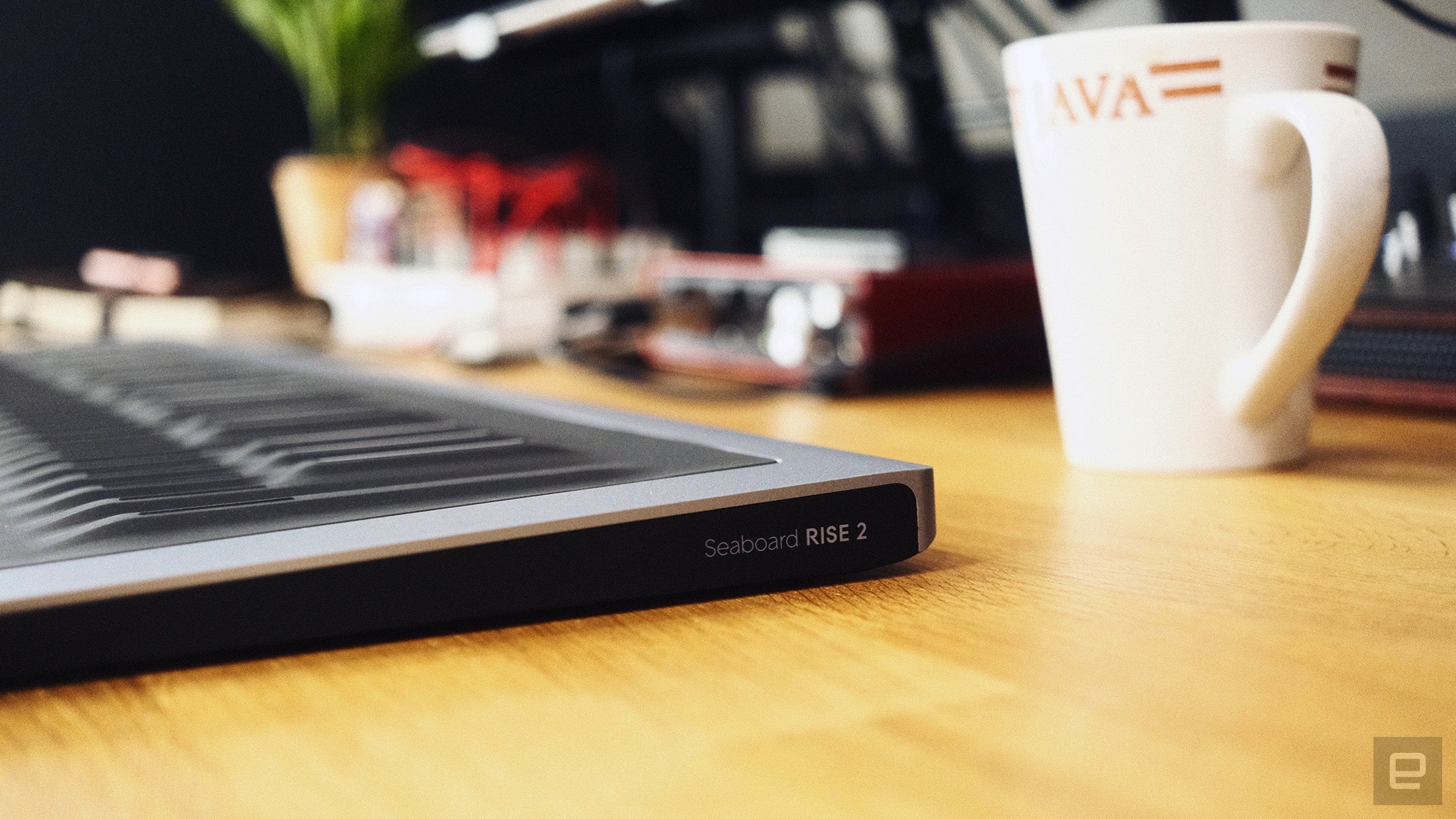
I’m, primarily, a guitarist. Dabbling in keys and synths has at all times felt a bit unnatural from a bodily standpoint. A keyboard doesn’t reply the way in which a fretted instrument does. This isn’t stunning, neither is it a nasty factor. It’s simply not what I’m used to. The higher a part of a decade into my journey with synthesizers, I nonetheless discover myself wiggling my fingers as if it’s going to create vibrato, or attempting to “bend” one observe whereas maintaining the opposite rooted to create shifting harmonies.
I’ve tried my share of MPE (MIDI Polyphonic Expression) controllers, which might seize a few of that nuance. However the Roli Seaboard Rise 2 is the primary I’ve performed that manages to ship all of that expressiveness with out additionally being an unmitigated headache ultimately. It’s most likely my new favourite MIDI controller. However, I nonetheless have a tough time recommending it to most individuals.
The instantly apparent challenge is the worth. $1,399 is so much of cash for a MIDI controller. There are some MIDI controllers that come shut, however they typically have extra beneficiant software program bundles; extra in depth controls (together with faders, knobs and pads); transport controls in your DAW; built-in arpeggiators or sequencers; and screens for viewing parameters and shopping presets.
In fact, what these controllers often lack is MPE performance. And it’s not just like the Seaboard Rise 2 isn’t a premium system. It’s constructed virtually solely from steel, save for the silicone keybed and the small collection of controls to its left. It feels extraordinarily sturdy, and I’m fairly positive I’d must exit of my strategy to do any important harm to it. Regardless of that, it’s additionally surprisingly skinny and light-weight. At roughly 33 inches, it’s barely longer than your common 49-key controller, nevertheless it’s lower than an inch thick and solely a hair over 12 kilos. And that’s regardless of having a battery that may final eight hours when related over Bluetooth. For comparability, Arturia’s batteryless Keylab 49 MKII is sort of 3 inches thick and suggestions the scales at 14 kilos.
I’d cease shy of calling it moveable, nevertheless it’s definitely luggable. I’ve moved it round my dwelling studio fairly a bit and it appears straightforward sufficient to tug to a gig, particularly in the event you decide up the $100 tender case.
You’re not shopping for the Seaboard Rise 2 for the portability, although. You’re right here for the continual “Keywave2” floor. And let me let you know, when you recover from how unusual it feels it’s fairly unimaginable.
It’s necessary to notice that I’ve by no means performed the unique Seaboard Rise. However I’ve used many different MPE controllers, together with Roli’s Blocks lineup. They’ve all had some type of important shortcoming, and the Roli Blocks had been borderline unusable. Nearly every little thing I’ve tried has felt both like a novelty or a prototype, moderately than a consumer-ready product. (The 2 exceptions to this being the newest Ableton Push and the Expressive E Osmose, although they’re very completely different units with drawbacks of their very own.) So, whereas I’m fascinated with MPE and assume there’s a whole lot of potential within the expertise, I got here into this overview with fairly low expectations.
However, the Seaboard Rise 2 seems like the primary time an organization has gotten virtually every little thing proper in a standalone MPE MIDI controller. The delicate “Precision Frets” make feeling your approach across the keyboard a lot simpler. I’m not a talented pianist or keyboard participant who’s doing lightning-quick scale runs based mostly solely on muscle reminiscence. Nonetheless, I welcomed their addition. They made it much more apparent once I ought to cease a slide and helped me make sure that my strikes had been centered on the keys so I didn’t find yourself sounding out of tune.
The squishy silicone keybed additionally supplies wonderful suggestions. Most different MPE units I’ve used have little or no journey, if any in any respect. You may as nicely be attempting to play on a espresso desk. Not the Seaboard. The “keys” (in the event you can actually name them that) jut up, providing you with a way for the place to place your fingers. The floor gently resists and bunches up underneath your finger whenever you’re performing slides, delivering a lot wanted tactile suggestions. There’s a whole lot of depth to the floor, too; this isn’t only a skinny silicone pores and skin laid excessive of some sensors. It’s not fairly as satisfying as feeling a key backside out beneath your fingers, nevertheless it’s really simpler to coax nuance out of the speed and aftertouch than on extra conventional controllers.
That skill to get delicate shifts in timbre, tone and pitch are what make MPE, and the Seaboard specifically, particular. With the proper mixture of {hardware} or software program, every observe performed can have its personal distinctive expression. A primary instance of this being controlling the filter cutoff of a synth patch with the slide parameter on the Seaboard. Meaning as you progress your finger from the underside of the management floor to the highest, the filter opens as much as create a brighter sound. However on this case you possibly can elevate the cutoff on the upper notes solely to emphasise the melody, whereas maintaining the decrease register muted and droning.
Giving every observe its personal distinctive velocity, cutoff, et cetera can add unimaginable depth to even essentially the most simplistic efficiency. In a extra superior instance of how this may work, think about a software program instrument based mostly on orchestral strings. On one thing just like the Seaboard Rise 2, shortly tapping the keys and instantly pulling off may very well be used to play pizzicato for stabbing chords. However calmly urgent into the silicone floor would produce a slower assault, permitting you to play languid melodies excessive of sharp harmonies. Sliding your finger as much as the highest might add light vibrato to emphasise specific notes, and dragging it left or proper would produce real looking glides which might be usually solely potential on an unfretted, stringed instrument, not a keyboard.
I spotlight that instance as a result of the Seaboard appears particularly suited to scoring work. Whereas it’s superb for enjoying your typical lead and bass patches, it separates itself from the pack when you begin exploring sounds which might be slower and have extra evolution. The slight dissonance I might introduce by shifting one finger simply barely off the middle of a key created this spooky environment that I saved getting misplaced in. Possibly it was simply the season I used to be doing most of my testing throughout, however all I saved desirous about was how a lot I wished to attain a horror film.
Clearly Roli is aware of it is a power, as a result of a whole lot of the presets in its Equator 2 softsynth appear geared towards soundtrack work. Usually, the plugin prices $249, however fortunately it’s included totally free with the Seaboard Rise 2. It simply does one of the best job of showcasing the controller’s numerous powers. The unlucky factor is, solely a little bit over a 3rd of the presets are MPE-compatible. And whereas it’s definitely a robust instrument, Equator 2 has various quirks that maintain it from feeling totally polished.
Maybe the largest of these points is that, whenever you first set up it, most of the manufacturing unit presets are utterly damaged and nonfunctional. That’s as a result of there are two extra libraries you must set up. However these are in a drop-down record, and there’s zero indication that anything is required till you really open the app and it repeatedly tells you that recordsdata are lacking. I uninstalled and reinstalled Equator and all its preset packs, hoping that might repair the problem. It was solely after some Googling that I found there have been extra required downloads hiding proper contained in the Roli Join app.
The Roli Dashboard at the very least feels rather less slapdash, and it’s arguably a extra important a part of the expertise. That is the place you’ll do all the required configuring, like selecting whether or not the Seaboard is in MPE mode or commonplace MIDI, choosing what MIDI CCs the XY pad controls and setting the sensitivity ranges of issues like glide and slide. You’ll principally at all times wish to have the Dashboard open as a result of, the unlucky fact is, MPE continues to be type of messy. Non-MPE-compatible devices and plugins won’t work proper in the event you don’t change the Rise to single channel mode. I’ve discovered getting MPE-enabled plugins to work correctly in Ableton Reside 11 a little bit tough.
Even whenever you do get an MPE-enabled instrument ({hardware} or software program) paired up with a controller just like the Seaboard Rise, you’ll most likely must do some finetuning to get them utterly in sync. For instance, you’ll have to ensure the pitch bend vary in each the Dashboard and no matter you’re controlling match up. If the Seaboard is about for a 48-note vary, however, let’s say, Pigments is about for less than two, slides won’t ever land the place you count on them and even narrowly lacking the deadcenter of a key will lead to chords which might be painfully out of tune.
When every little thing works, although, it’s fairly particular. The Seaboard Rise 2 is simpler to play and extra versatile than some other MPE MIDI controller I’ve tried. It’s most likely essentially the most profitable showcase of what’s potential with the expertise.
Positive, it’s costly, will be finicky to configure, and there are restricted choices for devices that reap the benefits of its full expressive capabilities. However MPE-capable softsynths are possible solely going to develop in recognition over the following few years. Most individuals ought to most likely maintain out and see what the consensus from reviewers is on the extra reasonably priced Seaboard Block M. However in the event you simply need one of the best MPE MIDI controller you possibly can at the moment purchase and don’t thoughts shelling out for a premium system, the Roli Seaboard Rise 2 is it.
This text initially appeared on Engadget at https://www.engadget.com/roli-seaboard-rise-2-review-i-wish-i-had-a-horror-movie-to-score-150028305.html?src=rss
This Article is Sourced Fromwww.engadget.com






